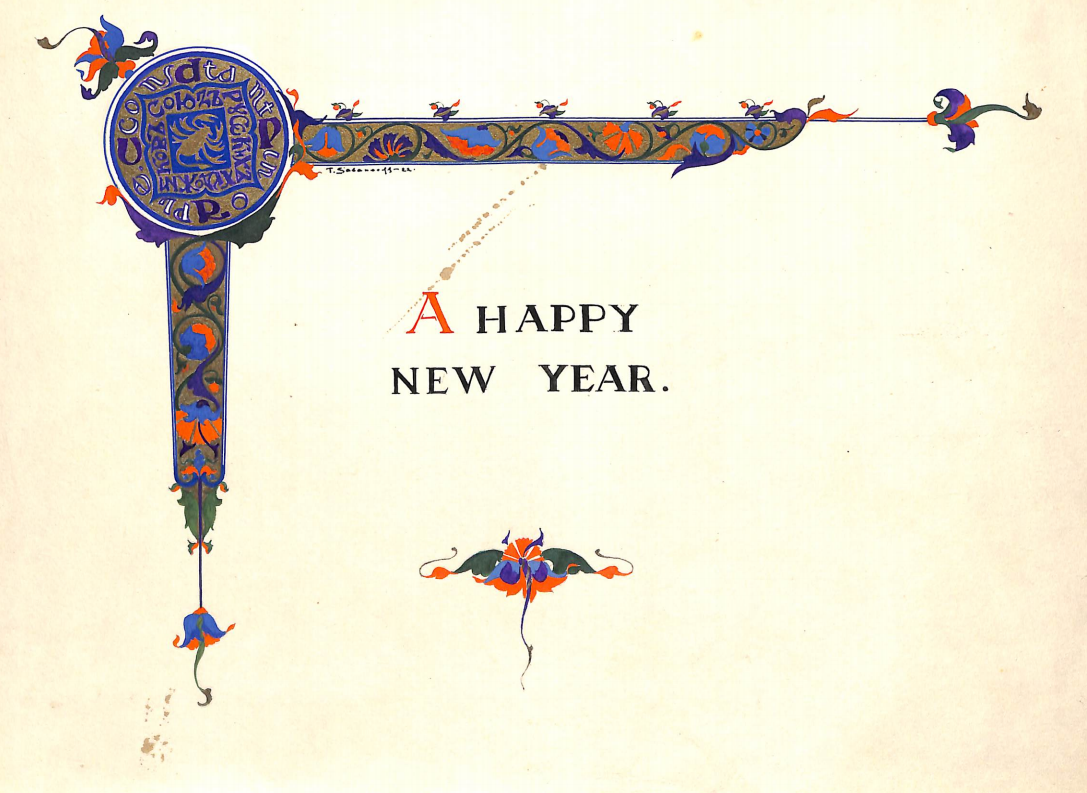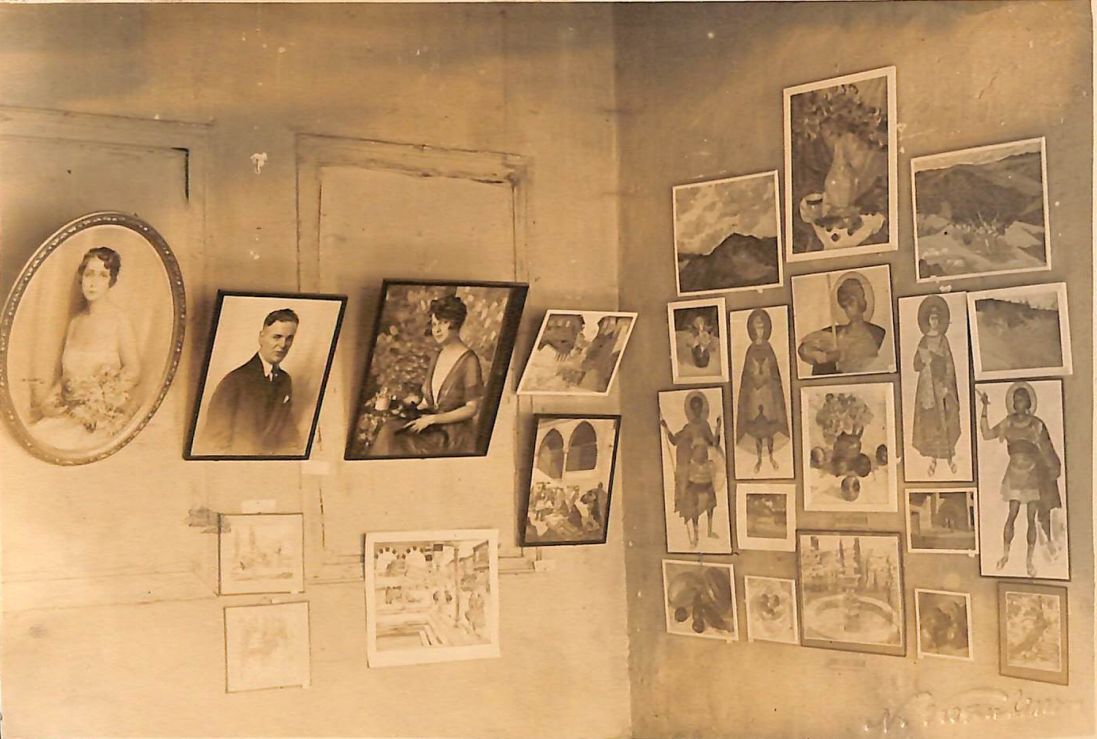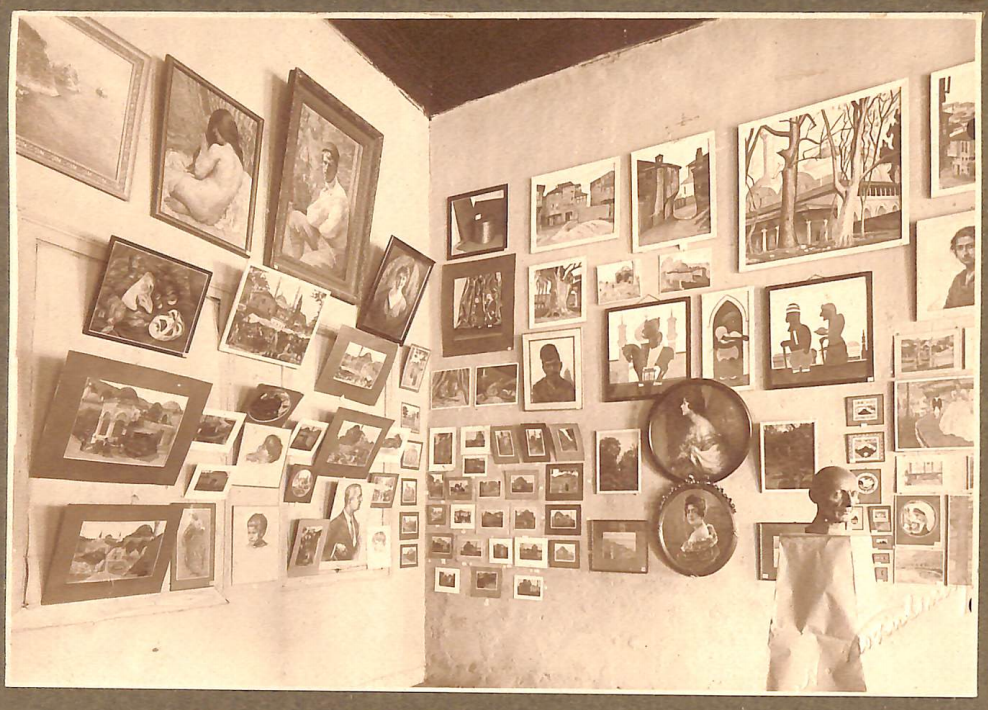Archive
Union of Russian Painters in Constantinople
- Union of Russian Painters in Constantinople
Society of Russian Artists in Constantinople, Союз Русских Художников Константинополя, Konstantinopolis Rus Ressamlar Birliği, Konstantinopolis Rus Sanatçılar Birliği
- Association
The Union existed for less than two years but in that short space of time a tremendous amount of work was done by its members, refugees from the Russian Empire.
Word Count: 30
The Russian Lighthouse (Mayak), Bursa Street 40 (now Sadri Alışık 40), Beyoğlu, Istanbul (studio); Küçük Yazıcı 4 (now presumably Tarlabaşı Blv. 79), Hüseyinağa, Beyoğlu, Istanbul (studio).

Union of Russian Painters in Constantinople logo from 1922 membership card of the Union of Russian Painters in Constantinople (Private Archive of Dimitri Ismailovitch that belongs to Eduardo Mendes Cavalcanti). 
Members of the Union of Russian Painters in Constantinople, Summer 1922. Source: Scrapbook “To Mr. and Mrs. Stearns from Russian Painters”, p. 8 (Stearns Family Papers. Archives & Special Collections. The College of the Holy Cross). 
1922 membership card of the Union of Russian Painters in Constantinople (Private Archive of Dimitri Ismailovitch that belongs to Eduardo Mendes Cavalcanti). 
Union of Russian Painters in Constantinople logo painted by T. Sabaneeff, 1922. Source: Scrapbook “To Mr. and Mrs. Stearns from Russian Painters”, p. 1 (Stearns Family Papers. Archives & Special Collections. The College of the Holy Cross). 
One of the exhibitions of the Union of Russian Painters in Constantinople, Summer 1922. Source: Scrapbook “To Mr. and Mrs. Stearns from Russian Painters”, p. 10 (Stearns Family Papers. Archives & Special Collections. The College of the Holy Cross). 
Exhibition of the Union of Russian Painters in Constantinople at Taksim military barracks, Summer 1922. Source: Scrapbook “To Mr. and Mrs. Stearns from Russian Painters”, p. 6 (Stearns Family Papers. Archives & Special Collections. The College of the Holy Cross). 
The Archives & Special Collections of The College of the Holy Cross holds a photograph portraying the members of the Union of Russian Painters in Constantinople. The photograph was displayed at the Occupied City/Meşgul Şehir Exhibition held at the Istanbul Research Institute. Ekaterina Aygün worked as a consultant for the exhibition (Photo: Burcu Dogramaci, 2023). Anonymous. “Odnodnevnaya Vystavka Kartin.” Presse du Soir, 10 October 1921, p. 4.
Anonymous. “Vystavka Soyuza Russkih Hudojnikov.” Presse du Soir, 19 June 1922, n.p.
Anonymous. “V Soyuze Hudojnikov.” Presse du Soir, 29 June 1922, n.p.
Anonymous. “Témoignage de sa gratitude de l’Association des Peintres russes à M. Stearns.” Presse du Soir, 27 November 1922, n.p.
Anonymous. “Soyuz Russkih Hudojnikov v Konstantinopole.” Presse du Soir, 28 November 1922, n.p.
Anonymous. “V Soyuze Hudojnikov.” Presse du Soir, 23 December 1922, p. 3.
Bournakine, Anatoliy, and Dominic Valery, editors. Al’manah Na Proschaniye. The Farewell Almanac. L’Almanach Nos Adieux (1920–1923). Imp. L. Babok & fils, 1923.
Bumgardner, Eugenia S. Undaunted Exiles. The McClure Company, 1925.
Novitskiy, G. “Pamyati hudojnika V.S. Ivanova.” Novoye Russkoye Slovo, 23 December 1965, n.p.
Ted’. “K Vystavke Hudojnikov.” Presse du Soir, 29 June 1923, n.p.
Word Count: 124
Slavonic Library (Slovanská knihovna) in Prague.
Archives & Special Collections at the College of the Holy Cross (Worcester, Massachusetts).
Private Archive of Dimitri Ismailovitch that belongs to Eduardo Mendes Cavalcanti (Rio de Janeiro, Brazil).
Word Count: 34
I wish to express my most sincere gratitude to the representatives of the Archives & Special Collections at the College of the Holy Cross (Worcester, Massachusetts) for their enormous assistance. I am also very grateful to Eduardo Mendes Cavalcanti for his valuable help. Finally I would like to thank the representatives of the Slavonic Library (Slovanská knihovna) in Prague for helping me tremendously during my work at the library.
Word Count: 69
- 01-1922
- 1923
- Istanbul
- Ekaterina Aygün. "Union of Russian Painters in Constantinople." METROMOD Archive, 2021, https://archive.metromod.net/viewer.p/69/2949/object/5145-10440425, last modified: 29-05-2023.
-
Boris EguizePainterIstanbul
In Istanbul, Eguize actively advanced in the field of portraiture. After he had become a member of the Union of Russian Painters, he was described as "an absolutely valuable acquisition".
Word Count: 30
Dimitri IsmailovitchPainterArt HistorianIstanbulIn Istanbul, Ismailovitch became one of the leaders of the Union of Russian Painters in Constantinople, organised three solo exhibitions, and made contribution to the study of Byzantine art.
Word Count: 29
Georges ArtemoffPainterSculptorIstanbulIt is difficult to say to what extent Istanbul was a fateful impact on Artemoff in terms of his artwork, but there he met his future wife, artist Lydia Nikanorova.
Word Count: 30
Iraida BarrySculptorIstanbulAfter the Russian Revolution of 1917, Barry settled in Istanbul, where she lived until her death. She is remembered as one of the first female sculptors of the Turkish Republic.
Word Count: 29
Nikolai BeckerPainterGraphic ArtistIstanbulNikolai Becker worked tirelessly in Turkey for three years. He created at least 168 portraits of men and women (among them admirals and their families, commanders-in-chief, diplomats, etc.).
Word Count: 27
Nikolai PeroffPainterArt restorerIconographerChoir DirectorCharitable Society’s ChairmanScene DesignerIstanbulNikolai Peroff lived in Istanbul until the end of his life. He was engaged in restorations, carried out scene decorations, and did a lot for the Russian churches in Karaköy.
Word Count: 31
Nikolai KalmykoffPainterScene DesignerMuralistIstanbulKalmykoff played an active part in the Union of Russian Painters in Constantinople and at the same time worked as a stage designer. Later he acquired the Turkish citizenship.
Word Count: 29
Nikolai VasilieffPainterScene DesignerMuralistIstanbulVasilieff was not only one of the Union of Russian Painters in Istanbul’s leaders, but he is also remembered for his stage settings and costumes for the ballet Scheherazade at the Theatre des Petits Champs.
Word Count: 36
Tatiana Alexinsky-LoukinaPainterArt CriticIstanbulTatiana Alexinsky-Loukina arrived in Istanbul with her husband in 1920. While living in Istanbul, she actively participated in exhibitions of the Union of Russian Painters in Constantinople.
Word Count: 26
V.P.-Tch.PainterScene DesignerMuralistIstanbulPainter V.P.-Tch. is perhaps the most mysterious figure of all Russian-speaking émigré painters who lived in Constantinople in the 1920s. Until now, almost all sources indicated only his initials.
Word Count: 31
Vladimir BobritskyPainterScene DesignerGraphic ArtistMusicianIstanbulBobritsky worked at the Theatre des Petits Champs, where he successfully dealt with stage designs and costumes, at the same time he participated in the Union of Russian Painters in Constantinople.
Word Count: 31
Wladimir IvanoffPainterSculptorIstanbulNot only did Ivanoff become one of the founders and chairman of the Union of Russian Painters in Constantinople, but he also became famous for “Drawing Thursdays”, which took place at his apartment.
Word Count: 33
Vladimir KadulinPainterCaricaturistIstanbulWhen it comes to Russian émigré caricaturists in Istanbul, Vladimir Kadulin who worked under the pseudonym Nayadin for the almanac Zarnitsy is the first to come to mind.
Word Count: 28
Mehmet Cemil CemDiplomatCaricaturistIstanbulCemil Cem is remembered as a cartoonist, although he also managed the Academy of Fine Arts in Istanbul for four years. While director of the academy, he supported Russian-speaking artists.
Word Count: 30
Foster Waterman StearnsLibrarianDiplomatCollectorPoliticianIstanbulFoster W. Stearns not only actively supported Russian-speaking émigré artists in Istanbul but also assembled a collection of their works which has survived to this day.
Word Count: 26
Lydia NikanorovaPainterIstanbulIn Istanbul, Nikanorova worked at copying the mosaics and frescoes of the Kariye Mosque, and met her future husband, Georges Artemoff, also an émigré artist from the former Russian Empire.
Word Count: 30
Nikolai SaraphanoffPainterIllustratorIstanbulThe artist is known for his numerous works with views of Istanbul, the design of the famous almanac’s cover, and the creation of decorative panels. Alas, his artistic activities were interrupted by his imprisonment.
Word Count: 35
Roman BilinskiPainterSculptorCollectorArt restorerIstanbulAt the beginning of the 1920s, a member of the Union of Russian Painters in Constantinople, Roman Bilinski was known as a sculptor. At the end of the 1920s–beginning of the 1930s – as a sculptor, painter and connoisseur of local antiques.
Word Count: 42
Ismet Inönü HeykeliMonumentIstanbulBetween 1941 and 1944 the Berlin sculptor Rudolf Belling worked on the Ismet Inönü Heykeli. The monument was placed in the neighbourhood of Maçka.
Word Count: 24
Russkiy v Konstantinopole/Le Russe à ConstantinopleGuide-bookIstanbulThe guide-book was created for Russian-speaking refugees who had to leave their country and settle in Constantinople.
Word Count: 17
First Russian émigré artists in Istanbul exhibitionExhibitionIstanbulThe first Russian-speaking émigré artists in Istanbul exhibition was a one-day event but its success led to the formation of the Union and paved the way for other exhibitions.
Word Count: 29
Exhibition of Russian émigré artists at Taksim Military BarracksExhibitionIstanbulThe exhibition of Russian-speaking émigré artists at Taksim Military Barracks was the first major exhibition organised by the Union of Russian Painters in Constantinople.
Word Count: 24
Nikolai SaretzkiPainterGraphic ArtistIllustratorArt CriticCollectorScene DesignerIstanbulSaretzki took a rather long exile route: from the Russian Empire he fled to Istanbul, from Istanbul to Berlin, from Berlin to Prague, and from Prague to Cormeilles-en-Parisis near Paris.
Word Count: 30
Pera Palace HotelHotelIstanbulThe Pera Palace was the gem of Pera district where people gathered to wine and dine and be entertained, as well as to discuss the issues of the day.
Word Count: 29